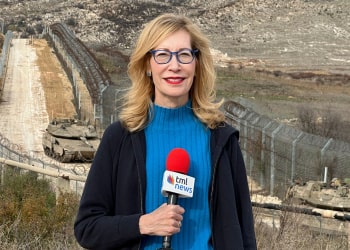[Gaza] The long-awaited reopening of the Netzarim Corridor in Gaza on Monday marked a pivotal moment for hundreds of thousands of Palestinians who have been displaced for more than 15 months. The corridor, a critical passage between the northern and southern parts of the Gaza Strip, was opened under a tightly controlled process coordinated by multiple actors, including Hamas, Israel, Egypt, and Qatar, with US oversight. The move came as part of a ceasefire agreement, underscoring ongoing international efforts to stabilize the region after prolonged conflict.
The crossing opened at 7 a.m., allowing pedestrians to travel along the Al-Rashid coastal road, while vehicles were permitted on Salah al-Din Street starting at 9 a.m., subject to stringent security checks. Only 100 cars per day are allowed to pass, with vehicles undergoing X-ray screenings for weapons and explosives.
The movement of the displaced citizens from the south to the north of Gaza, had coordination between us, the Hamas resistance, and the Israeli forces
Rami Yousef Ammar, a Palestinian police coordinator, noted the collaborative efforts, tell The Media Line, “The movement of the displaced citizens from the south to the north of Gaza, had coordination between us, the Hamas resistance, and the Israeli forces.”
This holiday season, give to:
Truth and understanding
The Media Line's intrepid correspondents are in Israel, Gaza, Lebanon, Syria and Pakistan providing first-person reporting.
They all said they cover it.
We see it.
We report with just one agenda: the truth.


Our feelings are indescribable. … Between the happiness and sadness for those who have left, and the destruction that we saw.
For many Gazans, the journey north evoked a mix of relief and heartbreak. Sahar Hamid, a resident of Gaza City, shared her emotions with The Media Line: “Our feelings are indescribable. … Between the happiness and sadness for those who have left, and the destruction that we saw, and what we will see in Gaza and the north. All the north has been destroyed. All the houses of my family have gone. Only the houses of a few people have remained. We don’t know where they will return to.”
The reopening follows a complex agreement involving the release of hostages held by Hamas. On Thursday, three hostages, including civilian Arbel Yehoud, are expected to be returned to Israel, ahead of a broader schedule for hostage releases. Disputes over the timing and composition of the releases had previously delayed the corridor’s reopening. Initially, the release of Israeli civilian hostages was prioritized, but a delay occurred when Hamas sought to exchange military personnel instead. The issue was resolved after intense negotiations led by Qatar and US intermediaries.
As displaced Palestinians began their return, the scale of destruction in northern Gaza became painfully evident. Roads lined with rubble and the ruins of once-vibrant neighborhoods greeted those who had hoped to find their homes intact.
Many walked for miles, carrying infants, belongings, and even gas tanks on their backs. The human column stretched for miles along the coastal highway, reflecting both desperation and determination.
International monitors, including US private contractors, played a critical role in ensuring the security of the passage. Egyptian personnel supervised vehicle inspections at key checkpoints, facilitating a process that many residents described as smooth despite its emotional weight.
The ceasefire agreement that enabled the reopening of the corridor is part of a broader truce brokered with the assistance of Qatar and the US. It stipulates that only unarmed individuals are permitted to return to northern Gaza. Despite this, some Gazans voiced concerns about the potential for renewed violence and the long-term implications of their return. Hamas and other Palestinian groups, including Islamic Jihad, have framed the reopening as a victory, rejecting suggestions by US officials that Palestinians should consider resettlement in neighboring countries such as Jordan and Egypt.
The situation in northern Gaza is dire. The Hamas-run government estimates that at least 135,000 tents and shelters are needed to accommodate those returning to the ruins of their homes. The humanitarian crisis remains severe, with the United Nations describing the situation as “dire” despite the influx of aid during the ceasefire. Food, fuel, and medical supplies have entered Gaza, but they are insufficient to meet the needs of a population grappling with immense loss and devastation.
The conflict, which began on October 7, 2023, when Hamas launched a large-scale attack on Israel, has left deep scars on both sides. In the ensuing months, Gaza faced relentless Israeli airstrikes and ground operations aimed at dismantling Hamas’ military capabilities. According to the Hamas-run Health Ministry, more than 47,000 Palestinians have been killed, though this figure includes both civilians and fighters. Israel estimates that around 20,000 Hamas combatants have been killed.
The reopening of the Netzarim Corridor represents a glimmer of hope for many Palestinians, but it also underscores the enormous challenges ahead. As families return to northern Gaza, they face the daunting task of rebuilding their lives in a landscape of destruction. The fragile truce offers a respite, but the path toward lasting peace remains uncertain in a region marked by decades of conflict and displacement.